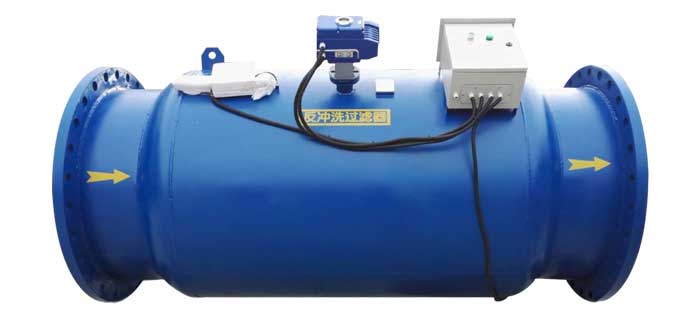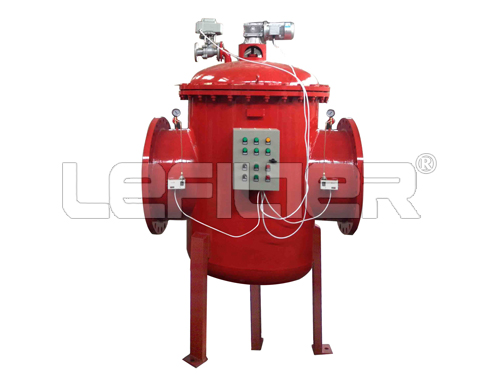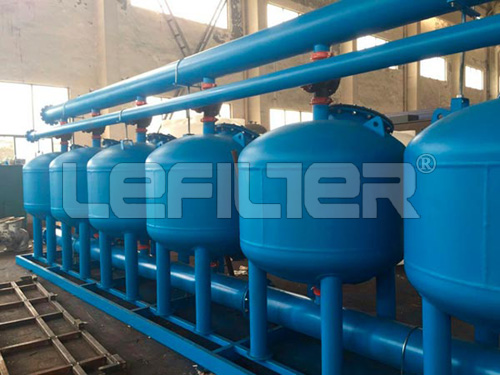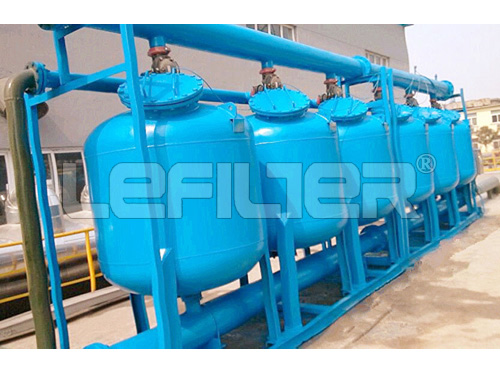A Backwash Filter, also known as a self-cleaning filter, is an advanced filtration system designed to provide continuous filtration of water while minimizing maintenance requirements. It is commonly used in various applications, including industrial processes, water treatment, irrigation, and more.
Design and Operation
The Backwash Filter consists of a filter housing, a filter screen, a backwash valve, a suction scanner, and a control system. The filter screen is the primary component that traps the impurities in the water. The backwash valve, controlled by the control system, allows for the discharge of these impurities during the backwash cycle.
The unique feature of a Backwash Filter is its self-cleaning mechanism. When the pressure differential across the filter screen reaches a certain level or after a set time interval, the filter initiates the backwash cycle. During this cycle, the backwash valve opens, and the suction scanner moves across the filter screen, sucking up the trapped impurities. These impurities are then discharged through the backwash valve.
Benefits
The Backwash Filter offers several benefits:
Continuous Operation: The self-cleaning mechanism allows for continuous filtration without the need for manual cleaning.
Efficient Filtration: The filter screen can trap a wide range of impurities, ensuring high-quality filtration.
Reduced Maintenance: The backwash cycle reduces the need for regular manual cleaning, saving time and effort.
Longevity: With proper installation and maintenance, a Backwash Filter can have a long operational life.
Versatility: It can be used in a wide range of applications, handling different types of water, including freshwater, seawater, and wastewater.
In conclusion, a Backwash Filter is a sophisticated, efficient, and reliable solution for various filtration needs. It combines the principles of filtration and self-cleaning to provide a high-quality, low-maintenance filtration system.

A Backwash Filter is a sophisticated piece of equipment designed to provide efficient and continuous filtration. It operates on the principle of backwashing, which is a cleaning method that ensures the filter remains effective over time. Here's a detailed explanation of how a Backwash Filter works:
Filtration Process
Water enters the filter housing and passes through the filter screen. This screen is designed to capture impurities and particles, allowing only clean water to pass through. The size of the impurities that the filter can trap depends on the micron rating of the filter screen.
Backwash Cycle Initiation
Over time, as more and more impurities are trapped, the pressure differential across the filter screen increases. When this pressure differential reaches a predetermined level, or after a set time interval, the control system initiates the backwash cycle.
Backwash Cycle
During the backwash cycle, the backwash valve opens, creating a reverse flow of water. A suction scanner, driven by the differential pressure, moves across the filter screen. The suction effect created cleans the filter screen, sucking up the trapped impurities.
Discharge of Impurities
The impurities collected during the backwash cycle are then discharged through the backwash valve. The backwash cycle is short and uses a minimal amount of water, ensuring efficient operation.
Return to Normal Operation
Once the backwash cycle is complete, the backwash valve closes, and the filter returns to its normal operation. The filter is now clean and ready to continue the filtration process.
Continuous Operation
One of the key features of a Backwash Filter is its ability to operate continuously. Even during the backwash cycle, the filtration process is not interrupted. This ensures a constant supply of filtered water.
In conclusion, the working principle of a Backwash Filter combines efficient filtration with a self-cleaning mechanism. This ensures high-quality filtration with minimal maintenance requirements, making it a reliable choice for various applications.
A Backwash Filter is a complex piece of equipment designed to provide efficient and continuous filtration of water. The filter is made up of several key components, each serving a specific function to ensure the overall operation of the system. Here's a detailed breakdown of the components of a Backwash Filter and their functions:
Filter Housing: The filter housing is the outer shell of the filter and serves to contain the water and other components of the filter. It is usually made of robust materials like stainless steel or plastic to withstand the pressure of the water flow and ensure durability.
Filter Screen: The filter screen is the heart of the Backwash Filter. It is responsible for trapping impurities in the water. The size of the impurities that the filter can trap is determined by the micron rating of the filter screen.
Backwash Valve: The backwash valve controls the flow of water during the backwash cycle. When the backwash cycle is initiated, the valve opens to allow a reverse flow of water, which is used to clean the filter screen.
Suction Scanner: The suction scanner is a critical component of the backwash cycle. It moves across the filter screen during the backwash cycle, sucking up the trapped impurities. The movement of the suction scanner is usually driven by the differential pressure across the filter screen.
Control System: The control system monitors the operation of the filter and initiates the backwash cycle when necessary. It can trigger the backwash cycle based on a set time interval or when the pressure differential across the filter screen reaches a certain level.
Pressure Differential Indicator: The pressure differential indicator provides a visual indication of the pressure differential across the filter screen. This can be used to monitor the performance of the filter and determine when the backwash cycle needs to be initiated.
In conclusion, each component of a Backwash Filter plays a crucial role in its operation. Together, they ensure efficient filtration of water with minimal maintenance requirements. The self-cleaning feature of the Backwash Filter, enabled by the backwash valve and the suction scanner, allows for continuous operation, making it an ideal choice for various applications.
The backwash valve plays a pivotal role in controlling the flow of water during the backwash cycle in a Backwash Filter. Here's a detailed explanation of how it works:
The backwash valve is typically a type of automatic valve that is controlled by the filter's control system. When the control system determines that a backwash cycle is necessary - either because of a set time interval or because the pressure differential across the filter screen has reached a certain level - it sends a signal to the backwash valve.
Upon receiving this signal, the backwash valve opens. This creates a pathway for water to flow in the reverse direction - from the outlet of the filter back towards the inlet. This reverse flow of water is what enables the backwash cycle.
The amount of water that flows during the backwash cycle is determined by the size of the opening in the backwash valve. The control system can adjust this opening to control the flow rate of the backwash water. This allows the backwash cycle to be carried out efficiently, using only a minimal amount of water.
During the backwash cycle, the backwash valve also serves to divert the backwash water, along with the impurities it has collected, out of the filter. Once the backwash cycle is complete, the control system sends another signal to the backwash valve, causing it to close. This stops the reverse flow of water and allows the filter to return to its normal operation.
In conclusion, the backwash valve is a critical component of a Backwash Filter. By controlling the flow of water during the backwash cycle, it enables the filter to clean itself, ensuring efficient and continuous operation.
Backwash Filters have several advantages and strengths that make them an excellent choice for water filtration systems. Here is a detailed explanation of the benefits of Backwash Filters:
Self-Cleaning: One of the most significant advantages of Backwash Filters is their self-cleaning ability. The backwash cycle, controlled by the backwash valve and executed by the suction scanner, cleans the filter screen by reversing the flow of water. This process removes the trapped impurities, reducing the need for manual cleaning and maintenance.
Continuous Operation: Due to their self-cleaning nature, Backwash Filters can operate continuously without the need for frequent shutdowns for cleaning. This continuous operation makes them highly efficient and ideal for systems that require constant filtration.
Versatility: Backwash Filters can be used to filter a wide range of impurities, from large particles to fine sediments, depending on the micron rating of the filter screen. This versatility makes them suitable for a variety of applications, including industrial processes, irrigation, and domestic water supply.
Durability: The robust construction of Backwash Filters, often made from materials like stainless steel or high-quality plastic, ensures their durability. They are designed to withstand high pressures and resist corrosion, providing a long service life.
Water Conservation: The backwash cycle is designed to use a minimal amount of water, making Backwash Filters an environmentally friendly choice. The control system can adjust the flow rate during the backwash cycle, ensuring that only the necessary amount of water is used.
Cost-Effective: While the initial investment for a Backwash Filter may be higher than for some other types of filters, the reduced maintenance requirements and long service life make it a cost-effective choice in the long run.
In conclusion, the advantages of Backwash Filters lie in their self-cleaning ability, continuous operation, versatility, durability, water conservation, and cost-effectiveness. These strengths make them an excellent choice for a wide range of water filtration applications.

The technical parameters and specifications of a Backwash Filter can vary greatly depending on the specific model and application. However, here are some general aspects that you might typically find in a Backwash Filter:
Size and Dimensions: The size of a Backwash Filter is often indicated by the diameter of the filter housing. Common sizes can range from a few inches for small, residential filters to several feet for industrial applications.
Pressure Rating: The pressure rating indicates the maximum pressure that the filter can withstand. This can vary depending on the material and construction of the filter, with some high-end models capable of handling pressures of several hundred psi.
Flow Rate: The flow rate is the amount of water that can pass through the filter in a given time, usually measured in gallons per minute (GPM) or cubic meters per hour (m3/h). The flow rate can depend on several factors, including the size of the filter, the micron rating of the filter screen, and the pressure of the water.
Micron Rating: The micron rating of the filter screen determines the smallest particle size that the filter can remove. Backwash Filters can have a wide range of micron ratings, from large (e.g., 100 microns) for coarse filtration to small (e.g., 10 microns or less) for fine filtration.
Backwash Flow Rate: The backwash flow rate is the amount of water used during the backwash cycle. This is typically a fraction of the main flow rate and is designed to be as low as possible to conserve water.
Control System: The control system for the backwash cycle can be either time-based, where the backwash cycle is initiated after a set time interval, or pressure-based, where the backwash cycle is initiated when the pressure differential across the filter screen reaches a certain level.
Materials: The materials used in the construction of the filter can vary, but common choices include stainless steel for the filter housing and screen, and high-quality plastic for the backwash valve.
Please note that these are general parameters and the actual specifications can vary depending on the specific model and manufacturer of the Backwash Filter. Always refer to the product datasheet or consult with the manufacturer for the exact specifications.
The material choices for backwash valves in a filtration system can vary depending on the specific application, durability needs, and cost considerations. Here are some common material choices:
Plastic/PVC: Plastic or PVC is a common material choice for backwash valves due to its cost-effectiveness and resistance to corrosion. These materials are ideal for applications where the valve is not exposed to high pressures or temperatures.
Brass: Brass is a popular material for backwash valves due to its durability and resistance to corrosion. Brass valves can withstand higher pressures and temperatures than plastic valves, making them suitable for more demanding applications.
Stainless Steel: Stainless steel is often used for backwash valves in high-end applications due to its excellent durability and resistance to both corrosion and high temperatures. Stainless steel valves are typically more expensive than brass or plastic valves but can offer a longer service life.
Bronze: Bronze is another durable material that is resistant to corrosion and can withstand high pressures and temperatures. Bronze valves are often used in marine applications due to their superior resistance to saltwater.
Composite Materials: Some backwash valves are made from composite materials, which can offer a good balance of durability, corrosion resistance, and cost-effectiveness. These materials can include combinations of plastics and metals, or advanced composites like fiberglass.
It's important to note that the best material for a backwash valve can depend on the specific requirements of the application, including the type of fluid being filtered, the operating pressure and temperature, and the environmental conditions. Always consult with a filtration expert or the valve manufacturer to determine the best material choice for your specific needs.
Backwash filters, also known as backflush filters or self-cleaning filters, are used in a wide range of industries due to their ability to provide continuous filtration with minimal maintenance. Here are some of the key industries where these filters are commonly used:
Water Treatment: Backwash filters are extensively used in water treatment plants for removing sediments, particulates, and other impurities from water. They are crucial in both drinking water production and wastewater treatment processes.
Oil and Gas Industry: These filters are used for separating solid particles from drilling muds in oil and gas extraction processes. They also help in refining operations to remove impurities from crude oil and natural gas.
Food and Beverage Industry: Backwash filters are used in the food and beverage industry to ensure the purity of water used in production processes and to filter out particulates from liquids such as juices, wines, and oils.
Chemical Industry: In the chemical industry, these filters are used to purify raw materials and process fluids, ensuring the consistency and quality of the end products.
Power Generation: Power plants, especially those using steam turbines, use backwash filters to clean the cooling water and boiler feed water to prevent damage to the equipment.
Pharmaceutical Industry: These filters are used in the pharmaceutical industry to ensure the purity of water used in production processes. They also help in filtering process fluids in the production of medicines and other pharmaceutical products.
Pulp and Paper Industry: Backwash filters are used in the pulp and paper industry to remove impurities from process water and to clean the wastewater before it is discharged.
Mining Industry: These filters are used in the mining industry to filter out particulates from process water and to clean wastewater before it is discharged.
Agriculture: In agriculture, backwash filters are used in irrigation systems to remove particulates from water, preventing clogging of the irrigation equipment.
These are just a few examples of the many industries where backwash filters are used. The common thread across all these applications is the need for continuous, reliable filtration to ensure the purity of water or other process fluids.
Installing and maintaining a backwash filter can vary depending on the specific model and application, but here are some general steps and considerations:
Installation:
Location: Choose a location for the filter that allows for easy access for maintenance and is close to a drain for backwashing. The location should also protect the filter from freezing temperatures and direct sunlight.
Assembly: Follow the manufacturer's instructions for assembling the filter. This typically involves attaching the filter head to the filter tank, connecting the inlet and outlet pipes, and installing the backwash drain line.
Filling the Tank: Fill the filter tank with the appropriate filter media, such as sand or activated carbon, as specified by the manufacturer.
Connecting the System: Connect the filter to the water supply line and the backwash drain line. Ensure all connections are secure to prevent leaks.
Start-Up: Slowly open the water supply valve and allow the filter tank to fill with water. Check for leaks and make any necessary adjustments. Follow the manufacturer's instructions for starting up the filter and initiating the first backwash cycle.
Maintenance:
Backwashing: Regular backwashing is the primary maintenance task for a backwash filter. The frequency of backwashing depends on the water quality and the filter's usage, but generally, it should be done every few weeks. The backwashing process involves reversing the water flow through the filter to flush out accumulated particles.
Media Replacement: Over time, the filter media will become exhausted and will need to be replaced. The frequency of media replacement depends on the water quality and the filter's usage, but generally, it should be done every few years.
Inspection: Regularly inspect the filter for leaks, damage, or signs of wear. Check the filter head, tank, and connections for any issues.
Cleaning: Clean the filter head and tank exterior as needed to remove dust, dirt, or other debris.
Professional Service: Depending on the filter model and local regulations, you may need to have the filter serviced by a professional periodically. This service can include a thorough inspection, testing, and any necessary repairs or adjustments.
Remember, always follow the manufacturer's instructions for installing and maintaining your backwash filter. If you're unsure about any aspect of the process, don't hesitate to consult with a professional.
Backwash filters play a significant role in environmental protection and have a profound social impact. Here's an in-depth look at how:
Environmental Impact:
Water Conservation: Backwash filters contribute to water conservation by cleaning and reusing water that would otherwise be wasted. By removing impurities from wastewater, it can be reused for various purposes like irrigation, reducing the overall water footprint.
Pollution Reduction: By filtering out harmful substances and contaminants from industrial waste, backwash filters prevent these pollutants from entering our water bodies. This helps in preserving aquatic ecosystems and reducing water pollution.
Resource Optimization: The use of backwash filters in industries helps in optimizing resources by recycling process water. This not only saves water but also reduces the energy and costs associated with treating and heating fresh water.
Social Impact:
Public Health: In the context of water treatment plants, backwash filters play a crucial role in ensuring the supply of clean and safe drinking water. By removing contaminants, they protect public health and prevent water-borne diseases.
Economic Savings: By enabling the reuse of water in industries and agriculture, backwash filters can lead to significant economic savings. They can also reduce the costs associated with waste disposal and environmental fines.
Sustainability Awareness: The use of backwash filters can raise awareness about water conservation and sustainability. It encourages responsible water use and can influence societal attitudes towards environmental protection.
Job Creation: The manufacture, installation, and maintenance of backwash filters also contribute to job creation in the water treatment sector.
In conclusion, backwash filters have a significant positive impact on the environment and society. They are a key tool in our efforts to achieve sustainable water management and protect public health.
{sval:sql sql='SELECT n_parameter FROM dede_addonarticle WHERE aid = ~aid~ ' } {/sval:sql}
{sval:sql sql='SELECT n_parameter FROM dede_addonarticle WHERE aid = ~aid~ ' } {/sval:sql}




















